标签:figure oat lib color 相关 das center 1.4 图片
import pandas as pd import numpy as np

M:月
# TIMES的几种书写方式 #2016 Jul 1; 7/1/2016; 1/7/2016 ;2016-07-01; 2016/07/01 rng = pd.date_range(‘2016-07-01‘, periods = 10, freq = ‘3D‘)#不传freq则默认是D rng
结果:

DatetimeIndex([‘2016-07-01‘, ‘2016-07-04‘, ‘2016-07-07‘, ‘2016-07-10‘, ‘2016-07-13‘, ‘2016-07-16‘, ‘2016-07-19‘, ‘2016-07-22‘, ‘2016-07-25‘, ‘2016-07-28‘], dtype=‘datetime64[ns]‘, freq=‘3D‘)
time=pd.Series(np.random.randn(20),
index=pd.date_range(dt.datetime(2016,1,1),periods=20))
print(time)
#结果:
2016-01-01 -0.129379
2016-01-02 0.164480
2016-01-03 -0.639117
2016-01-04 -0.427224
2016-01-05 2.055133
2016-01-06 1.116075
2016-01-07 0.357426
2016-01-08 0.274249
2016-01-09 0.834405
2016-01-10 -0.005444
2016-01-11 -0.134409
2016-01-12 0.249318
2016-01-13 -0.297842
2016-01-14 -0.128514
2016-01-15 0.063690
2016-01-16 -2.246031
2016-01-17 0.359552
2016-01-18 0.383030
2016-01-19 0.402717
2016-01-20 -0.694068
Freq: D, dtype: float64
time.truncate(before=‘2016-1-10‘)#1月10之前的都被过滤掉了
结果:

2016-01-10 -0.005444
2016-01-11 -0.134409
2016-01-12 0.249318
2016-01-13 -0.297842
2016-01-14 -0.128514
2016-01-15 0.063690
2016-01-16 -2.246031
2016-01-17 0.359552
2016-01-18 0.383030
2016-01-19 0.402717
2016-01-20 -0.694068
Freq: D, dtype: float64
time.truncate(after=‘2016-1-10‘)#1月10之后的都被过滤掉了 #结果: 2016-01-01 -0.129379 2016-01-02 0.164480 2016-01-03 -0.639117 2016-01-04 -0.427224 2016-01-05 2.055133 2016-01-06 1.116075 2016-01-07 0.357426 2016-01-08 0.274249 2016-01-09 0.834405 2016-01-10 -0.005444 Freq: D, dtype: float64
print(time[‘2016-01-15‘])#0.063690487247
print(time[‘2016-01-15‘:‘2016-01-20‘])
结果:
2016-01-15 0.063690
2016-01-16 -2.246031
2016-01-17 0.359552
2016-01-18 0.383030
2016-01-19 0.402717
2016-01-20 -0.694068
Freq: D, dtype: float64
data=pd.date_range(‘2010-01-01‘,‘2011-01-01‘,freq=‘M‘)
print(data)
#结果:
DatetimeIndex([‘2010-01-31‘, ‘2010-02-28‘, ‘2010-03-31‘, ‘2010-04-30‘,
‘2010-05-31‘, ‘2010-06-30‘, ‘2010-07-31‘, ‘2010-08-31‘,
‘2010-09-30‘, ‘2010-10-31‘, ‘2010-11-30‘, ‘2010-12-31‘],
dtype=‘datetime64[ns]‘, freq=‘M‘)
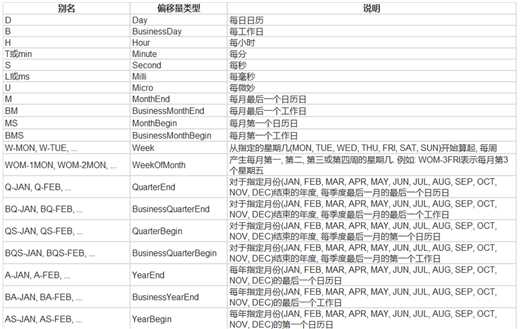
#时间戳
pd.Timestamp(‘2016-07-10‘)#Timestamp(‘2016-07-10 00:00:00‘)
# 可以指定更多细节
pd.Timestamp(‘2016-07-10 10‘)#Timestamp(‘2016-07-10 10:00:00‘)
pd.Timestamp(‘2016-07-10 10:15‘)#Timestamp(‘2016-07-10 10:15:00‘)
# How much detail can you add?
t = pd.Timestamp(‘2016-07-10 10:15‘)
# 时间区间
pd.Period(‘2016-01‘)#Period(‘2016-01‘, ‘M‘)
pd.Period(‘2016-01-01‘)#Period(‘2016-01-01‘, ‘D‘)
# TIME OFFSETS
pd.Timedelta(‘1 day‘)#Timedelta(‘1 days 00:00:00‘)
pd.Period(‘2016-01-01 10:10‘) + pd.Timedelta(‘1 day‘)#Period(‘2016-01-02 10:10‘, ‘T‘)
pd.Timestamp(‘2016-01-01 10:10‘) + pd.Timedelta(‘1 day‘)#Timestamp(‘2016-01-02 10:10:00‘)
pd.Timestamp(‘2016-01-01 10:10‘) + pd.Timedelta(‘15 ns‘)#Timestamp(‘2016-01-01 10:10:00.000000015‘)
p1 = pd.period_range(‘2016-01-01 10:10‘, freq = ‘25H‘, periods = 10)
p2 = pd.period_range(‘2016-01-01 10:10‘, freq = ‘1D1H‘, periods = 10)
p1
p2
结果:
PeriodIndex([‘2016-01-01 10:00‘, ‘2016-01-02 11:00‘, ‘2016-01-03 12:00‘,
‘2016-01-04 13:00‘, ‘2016-01-05 14:00‘, ‘2016-01-06 15:00‘,
‘2016-01-07 16:00‘, ‘2016-01-08 17:00‘, ‘2016-01-09 18:00‘,
‘2016-01-10 19:00‘],
dtype=‘period[25H]‘, freq=‘25H‘)
PeriodIndex([‘2016-01-01 10:00‘, ‘2016-01-02 11:00‘, ‘2016-01-03 12:00‘,
‘2016-01-04 13:00‘, ‘2016-01-05 14:00‘, ‘2016-01-06 15:00‘,
‘2016-01-07 16:00‘, ‘2016-01-08 17:00‘, ‘2016-01-09 18:00‘,
‘2016-01-10 19:00‘],
dtype=‘period[25H]‘, freq=‘25H‘)
# 指定索引
rng = pd.date_range(‘2016 Jul 1‘, periods = 10, freq = ‘D‘)
rng
pd.Series(range(len(rng)), index = rng)
结果:
2016-07-01 0
2016-07-02 1
2016-07-03 2
2016-07-04 3
2016-07-05 4
2016-07-06 5
2016-07-07 6
2016-07-08 7
2016-07-09 8
2016-07-10 9
Freq: D, dtype: int32
periods = [pd.Period(‘2016-01‘), pd.Period(‘2016-02‘), pd.Period(‘2016-03‘)]
ts = pd.Series(np.random.randn(len(periods)), index = periods)
ts
结果:
2016-01 -0.015837
2016-02 -0.923463
2016-03 -0.485212
Freq: M, dtype: float64
type(ts.index)#pandas.core.indexes.period.PeriodIndex
# 时间戳和时间周期可以转换
ts = pd.Series(range(10), pd.date_range(‘07-10-16 8:00‘, periods = 10, freq = ‘H‘))
ts
结果:
2016-07-10 08:00:00 0
2016-07-10 09:00:00 1
2016-07-10 10:00:00 2
2016-07-10 11:00:00 3
2016-07-10 12:00:00 4
2016-07-10 13:00:00 5
2016-07-10 14:00:00 6
2016-07-10 15:00:00 7
2016-07-10 16:00:00 8
2016-07-10 17:00:00 9
Freq: H, dtype: int32
ts_period = ts.to_period()
ts_period
结果:
2016-07-10 08:00 0
2016-07-10 09:00 1
2016-07-10 10:00 2
2016-07-10 11:00 3
2016-07-10 12:00 4
2016-07-10 13:00 5
2016-07-10 14:00 6
2016-07-10 15:00 7
2016-07-10 16:00 8
2016-07-10 17:00 9
Freq: H, dtype: int32
时间周期与时间戳的区别
ts_period[‘2016-07-10 08:30‘:‘2016-07-10 11:45‘] #时间周期包含08:00
结果:
2016-07-10 08:00 0
2016-07-10 09:00 1
2016-07-10 10:00 2
2016-07-10 11:00 3
Freq: H, dtype: int32
ts[‘2016-07-10 08:30‘:‘2016-07-10 11:45‘] #时间戳不包含08:30
#结果:
2016-07-10 09:00:00 1
2016-07-10 10:00:00 2
2016-07-10 11:00:00 3
Freq: H, dtype: int32
import pandas as pd
import numpy as np
rng = pd.date_range(‘1/1/2011‘, periods=90, freq=‘D‘)#数据按天
ts = pd.Series(np.random.randn(len(rng)), index=rng)
ts.head()
结果:
2011-01-01 -1.025562
2011-01-02 0.410895
2011-01-03 0.660311
2011-01-04 0.710293
2011-01-05 0.444985
Freq: D, dtype: float64
ts.resample(‘M‘).sum()#数据降采样,降为月,指标是求和,也可以平均,自己指定
结果:
2011-01-31 2.510102
2011-02-28 0.583209
2011-03-31 2.749411
Freq: M, dtype: float64
ts.resample(‘3D‘).sum()#数据降采样,降为3天
结果:
2011-01-01 0.045643
2011-01-04 -2.255206
2011-01-07 0.571142
2011-01-10 0.835032
2011-01-13 -0.396766
2011-01-16 -1.156253
2011-01-19 -1.286884
2011-01-22 2.883952
2011-01-25 1.566908
2011-01-28 1.435563
2011-01-31 0.311565
2011-02-03 -2.541235
2011-02-06 0.317075
2011-02-09 1.598877
2011-02-12 -1.950509
2011-02-15 2.928312
2011-02-18 -0.733715
2011-02-21 1.674817
2011-02-24 -2.078872
2011-02-27 2.172320
2011-03-02 -2.022104
2011-03-05 -0.070356
2011-03-08 1.276671
2011-03-11 -2.835132
2011-03-14 -1.384113
2011-03-17 1.517565
2011-03-20 -0.550406
2011-03-23 0.773430
2011-03-26 2.244319
2011-03-29 2.951082
Freq: 3D, dtype: float64
day3Ts = ts.resample(‘3D‘).mean()
day3Ts
结果:
2011-01-01 0.015214
2011-01-04 -0.751735
2011-01-07 0.190381
2011-01-10 0.278344
2011-01-13 -0.132255
2011-01-16 -0.385418
2011-01-19 -0.428961
2011-01-22 0.961317
2011-01-25 0.522303
2011-01-28 0.478521
2011-01-31 0.103855
2011-02-03 -0.847078
2011-02-06 0.105692
2011-02-09 0.532959
2011-02-12 -0.650170
2011-02-15 0.976104
2011-02-18 -0.244572
2011-02-21 0.558272
2011-02-24 -0.692957
2011-02-27 0.724107
2011-03-02 -0.674035
2011-03-05 -0.023452
2011-03-08 0.425557
2011-03-11 -0.945044
2011-03-14 -0.461371
2011-03-17 0.505855
2011-03-20 -0.183469
2011-03-23 0.257810
2011-03-26 0.748106
2011-03-29 0.983694
Freq: 3D, dtype: float64
print(day3Ts.resample(‘D‘).asfreq())#升采样,要进行插值
结果:
2011-01-01 0.015214
2011-01-02 NaN
2011-01-03 NaN
2011-01-04 -0.751735
2011-01-05 NaN
2011-01-06 NaN
2011-01-07 0.190381
2011-01-08 NaN
2011-01-09 NaN
2011-01-10 0.278344
2011-01-11 NaN
2011-01-12 NaN
2011-01-13 -0.132255
2011-01-14 NaN
2011-01-15 NaN
2011-01-16 -0.385418
2011-01-17 NaN
2011-01-18 NaN
2011-01-19 -0.428961
2011-01-20 NaN
2011-01-21 NaN
2011-01-22 0.961317
2011-01-23 NaN
2011-01-24 NaN
2011-01-25 0.522303
2011-01-26 NaN
2011-01-27 NaN
2011-01-28 0.478521
2011-01-29 NaN
2011-01-30 NaN
...
2011-02-28 NaN
2011-03-01 NaN
2011-03-02 -0.674035
2011-03-03 NaN
2011-03-04 NaN
2011-03-05 -0.023452
2011-03-06 NaN
2011-03-07 NaN
2011-03-08 0.425557
2011-03-09 NaN
2011-03-10 NaN
2011-03-11 -0.945044
2011-03-12 NaN
2011-03-13 NaN
2011-03-14 -0.461371
2011-03-15 NaN
2011-03-16 NaN
2011-03-17 0.505855
2011-03-18 NaN
2011-03-19 NaN
2011-03-20 -0.183469
2011-03-21 NaN
2011-03-22 NaN
2011-03-23 0.257810
2011-03-24 NaN
2011-03-25 NaN
2011-03-26 0.748106
2011-03-27 NaN
2011-03-28 NaN
2011-03-29 0.983694
Freq: D, Length: 88, dtype: float64
day3Ts.resample(‘D‘).ffill(1)
结果:
2011-01-01 0.015214
2011-01-02 0.015214
2011-01-03 NaN
2011-01-04 -0.751735
2011-01-05 -0.751735
2011-01-06 NaN
2011-01-07 0.190381
2011-01-08 0.190381
2011-01-09 NaN
2011-01-10 0.278344
2011-01-11 0.278344
2011-01-12 NaN
2011-01-13 -0.132255
2011-01-14 -0.132255
2011-01-15 NaN
2011-01-16 -0.385418
2011-01-17 -0.385418
2011-01-18 NaN
2011-01-19 -0.428961
2011-01-20 -0.428961
2011-01-21 NaN
2011-01-22 0.961317
2011-01-23 0.961317
2011-01-24 NaN
2011-01-25 0.522303
2011-01-26 0.522303
2011-01-27 NaN
2011-01-28 0.478521
2011-01-29 0.478521
2011-01-30 NaN
...
2011-02-28 0.724107
2011-03-01 NaN
2011-03-02 -0.674035
2011-03-03 -0.674035
2011-03-04 NaN
2011-03-05 -0.023452
2011-03-06 -0.023452
2011-03-07 NaN
2011-03-08 0.425557
2011-03-09 0.425557
2011-03-10 NaN
2011-03-11 -0.945044
2011-03-12 -0.945044
2011-03-13 NaN
2011-03-14 -0.461371
2011-03-15 -0.461371
2011-03-16 NaN
2011-03-17 0.505855
2011-03-18 0.505855
2011-03-19 NaN
2011-03-20 -0.183469
2011-03-21 -0.183469
2011-03-22 NaN
2011-03-23 0.257810
2011-03-24 0.257810
2011-03-25 NaN
2011-03-26 0.748106
2011-03-27 0.748106
2011-03-28 NaN
2011-03-29 0.983694
Freq: D, Length: 88, dtype: float64
day3Ts.resample(‘D‘).bfill(1)
结果:
2011-01-01 0.015214
2011-01-02 NaN
2011-01-03 -0.751735
2011-01-04 -0.751735
2011-01-05 NaN
2011-01-06 0.190381
2011-01-07 0.190381
2011-01-08 NaN
2011-01-09 0.278344
2011-01-10 0.278344
2011-01-11 NaN
2011-01-12 -0.132255
2011-01-13 -0.132255
2011-01-14 NaN
2011-01-15 -0.385418
2011-01-16 -0.385418
2011-01-17 NaN
2011-01-18 -0.428961
2011-01-19 -0.428961
2011-01-20 NaN
2011-01-21 0.961317
2011-01-22 0.961317
2011-01-23 NaN
2011-01-24 0.522303
2011-01-25 0.522303
2011-01-26 NaN
2011-01-27 0.478521
2011-01-28 0.478521
2011-01-29 NaN
2011-01-30 0.103855
...
2011-02-28 NaN
2011-03-01 -0.674035
2011-03-02 -0.674035
2011-03-03 NaN
2011-03-04 -0.023452
2011-03-05 -0.023452
2011-03-06 NaN
2011-03-07 0.425557
2011-03-08 0.425557
2011-03-09 NaN
2011-03-10 -0.945044
2011-03-11 -0.945044
2011-03-12 NaN
2011-03-13 -0.461371
2011-03-14 -0.461371
2011-03-15 NaN
2011-03-16 0.505855
2011-03-17 0.505855
2011-03-18 NaN
2011-03-19 -0.183469
2011-03-20 -0.183469
2011-03-21 NaN
2011-03-22 0.257810
2011-03-23 0.257810
2011-03-24 NaN
2011-03-25 0.748106
2011-03-26 0.748106
2011-03-27 NaN
2011-03-28 0.983694
2011-03-29 0.983694
Freq: D, Length: 88, dtype: float64
day3Ts.resample(‘D‘).interpolate(‘linear‘)#线性拟合填充
结果:
2011-01-01 0.015214
2011-01-02 -0.240435
2011-01-03 -0.496085
2011-01-04 -0.751735
2011-01-05 -0.437697
2011-01-06 -0.123658
2011-01-07 0.190381
2011-01-08 0.219702
2011-01-09 0.249023
2011-01-10 0.278344
2011-01-11 0.141478
2011-01-12 0.004611
2011-01-13 -0.132255
2011-01-14 -0.216643
2011-01-15 -0.301030
2011-01-16 -0.385418
2011-01-17 -0.399932
2011-01-18 -0.414447
2011-01-19 -0.428961
2011-01-20 0.034465
2011-01-21 0.497891
2011-01-22 0.961317
2011-01-23 0.814979
2011-01-24 0.668641
2011-01-25 0.522303
2011-01-26 0.507709
2011-01-27 0.493115
2011-01-28 0.478521
2011-01-29 0.353632
2011-01-30 0.228744
...
2011-02-28 0.258060
2011-03-01 -0.207988
2011-03-02 -0.674035
2011-03-03 -0.457174
2011-03-04 -0.240313
2011-03-05 -0.023452
2011-03-06 0.126218
2011-03-07 0.275887
2011-03-08 0.425557
2011-03-09 -0.031310
2011-03-10 -0.488177
2011-03-11 -0.945044
2011-03-12 -0.783820
2011-03-13 -0.622595
2011-03-14 -0.461371
2011-03-15 -0.138962
2011-03-16 0.183446
2011-03-17 0.505855
2011-03-18 0.276080
2011-03-19 0.046306
2011-03-20 -0.183469
2011-03-21 -0.036376
2011-03-22 0.110717
2011-03-23 0.257810
2011-03-24 0.421242
2011-03-25 0.584674
2011-03-26 0.748106
2011-03-27 0.826636
2011-03-28 0.905165
2011-03-29 0.983694
Freq: D, Length: 88, dtype: float64
滑动窗口就是能够根据指定的单位长度来框住时间序列,从而计算框内的统计指标。相当于一个长度指定的滑块在刻度尺上面滑动,每滑动一个单位即可反馈滑块内的数据。
滑动窗口可以使数据更加平稳,浮动范围会比较小,具有代表性,单独拿出一个数据可能或多或少会离群,有差异或者错误,使用滑动窗口会更规范一些。
%matplotlib inline
import matplotlib.pylab
import numpy as np
import pandas as pd
df = pd.Series(np.random.randn(600), index = pd.date_range(‘7/1/2016‘, freq = ‘D‘, periods = 600))
df.head()
结果:
2016-07-01 -0.192140
2016-07-02 0.357953
2016-07-03 -0.201847
2016-07-04 -0.372230
2016-07-05 1.414753
Freq: D, dtype: float64
r = df.rolling(window = 10)
r#Rolling [window=10,center=False,axis=0]
#r.max, r.median, r.std, r.skew倾斜度, r.sum, r.var
print(r.mean())
结果:
2016-07-01 NaN
2016-07-02 NaN
2016-07-03 NaN
2016-07-04 NaN
2016-07-05 NaN
2016-07-06 NaN
2016-07-07 NaN
2016-07-08 NaN
2016-07-09 NaN
2016-07-10 0.300133
2016-07-11 0.284780
2016-07-12 0.252831
2016-07-13 0.220699
2016-07-14 0.167137
2016-07-15 0.018593
2016-07-16 -0.061414
2016-07-17 -0.134593
2016-07-18 -0.153333
2016-07-19 -0.218928
2016-07-20 -0.169426
2016-07-21 -0.219747
2016-07-22 -0.181266
2016-07-23 -0.173674
2016-07-24 -0.130629
2016-07-25 -0.166730
2016-07-26 -0.233044
2016-07-27 -0.256642
2016-07-28 -0.280738
2016-07-29 -0.289893
2016-07-30 -0.379625
...
2018-01-22 -0.211467
2018-01-23 0.034996
2018-01-24 -0.105910
2018-01-25 -0.145774
2018-01-26 -0.089320
2018-01-27 -0.164370
2018-01-28 -0.110892
2018-01-29 -0.205786
2018-01-30 -0.101162
2018-01-31 -0.034760
2018-02-01 0.229333
2018-02-02 0.043741
2018-02-03 0.052837
2018-02-04 0.057746
2018-02-05 -0.071401
2018-02-06 -0.011153
2018-02-07 -0.045737
2018-02-08 -0.021983
2018-02-09 -0.196715
2018-02-10 -0.063721
2018-02-11 -0.289452
2018-02-12 -0.050946
2018-02-13 -0.047014
2018-02-14 0.048754
2018-02-15 0.143949
2018-02-16 0.424823
2018-02-17 0.361878
2018-02-18 0.363235
2018-02-19 0.517436
2018-02-20 0.368020
Freq: D, Length: 600, dtype: float64
import matplotlib.pyplot as plt
%matplotlib inline
plt.figure(figsize=(15, 5))
df.plot(style=‘r--‘)
df.rolling(window=10).mean().plot(style=‘b‘)#<matplotlib.axes._subplots.AxesSubplot at 0x249627fb6d8>
结果:
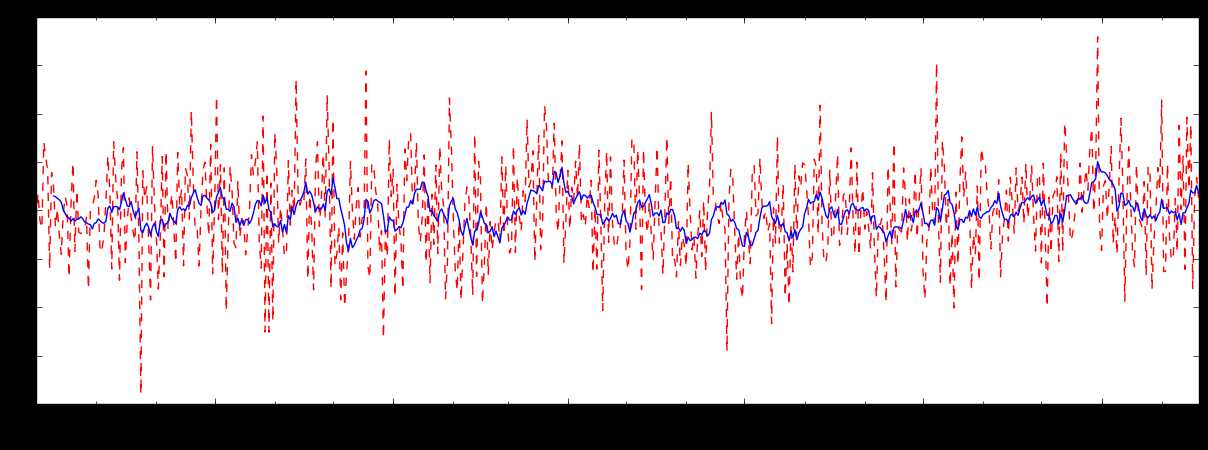
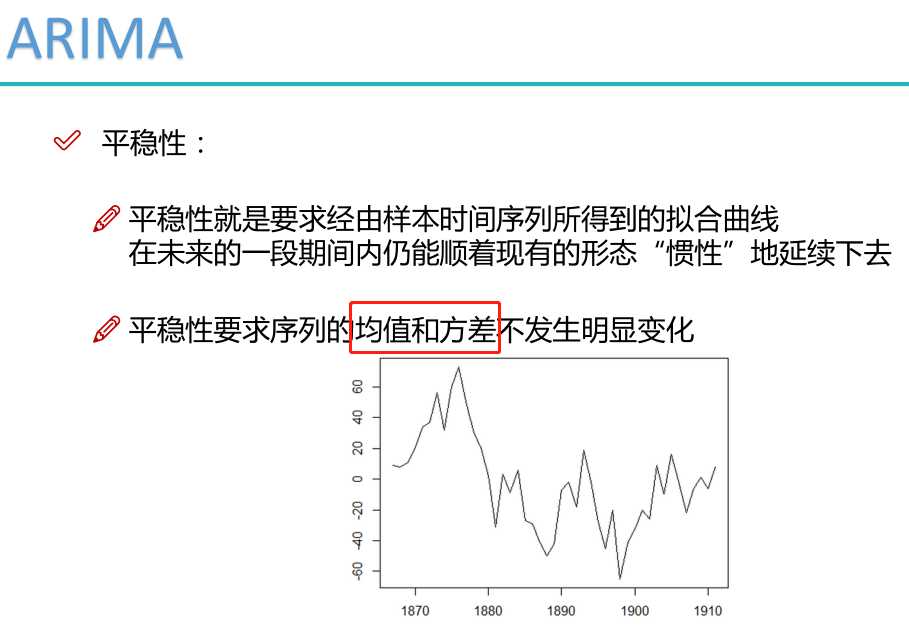
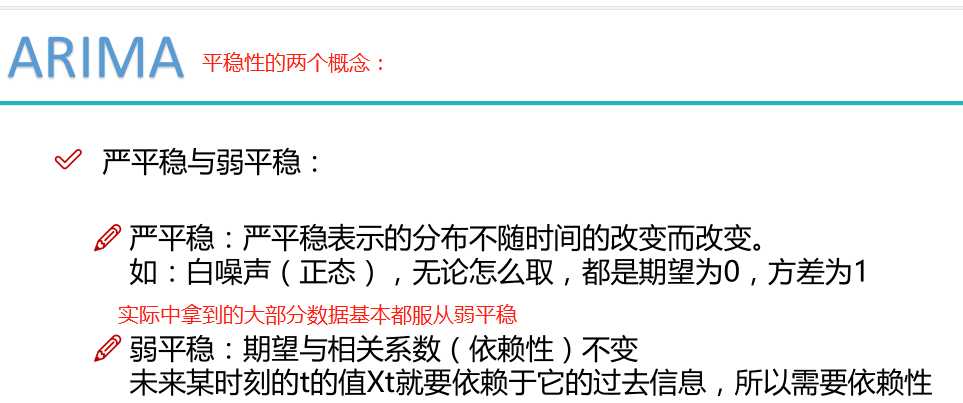

二阶差分是指在一阶差分基础上再做一阶差分。

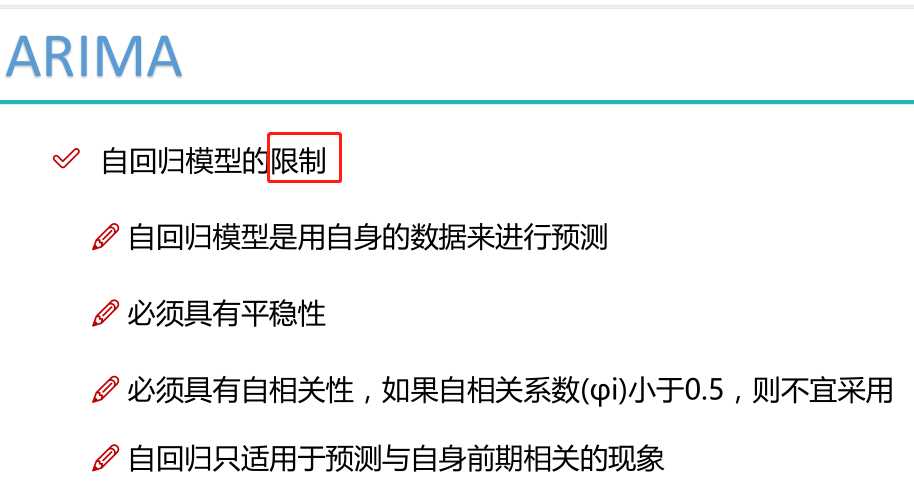
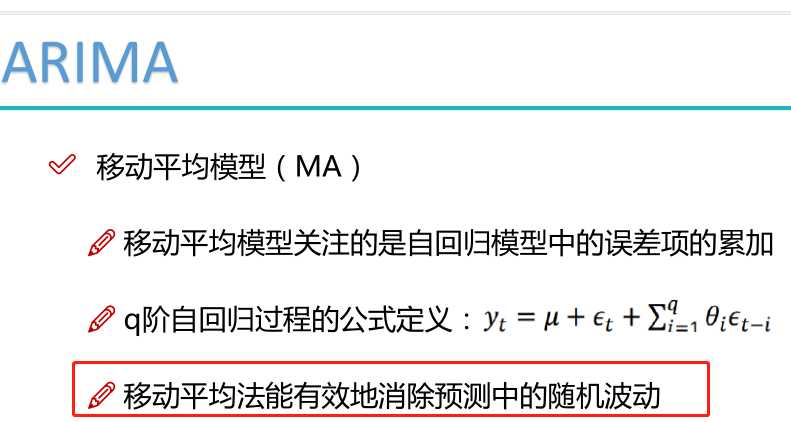


标签:figure oat lib color 相关 das center 1.4 图片
原文地址:https://www.cnblogs.com/tianqizhi/p/9277376.html